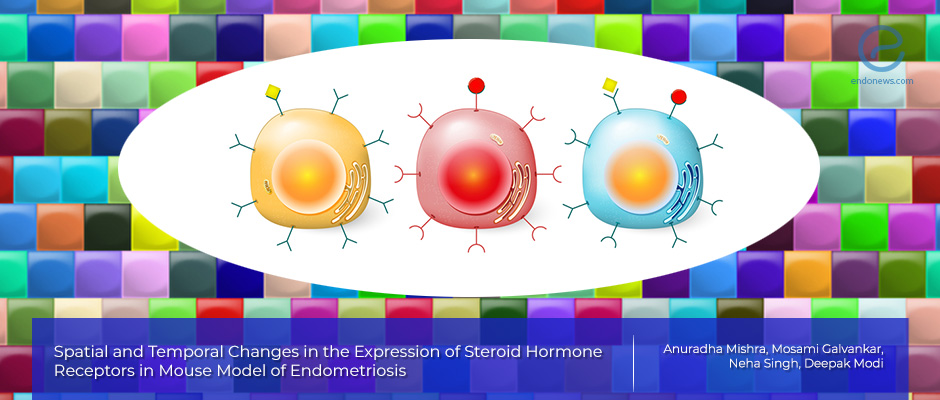Steroid hormone receptors in endometriosis
May 5, 2020
Microheterogeneity of steroid hormone receptors expression in endometriosis may be the cause of the ineffectiveness of hormonal treatments
Key Points
Highlight:
- Endometriotic tissue shows a high degree of inter- and intra-lesion heterogeneity in terms of steroid receptor expression.
Importance:
- Variation in the outcomes of hormonal therapy for endometriosis treatment may be caused by heterogeneity in steroid hormone receptors in the ectopic endometrium.
What's done here:
- The mouse model of endometriosis was generated using an autologous uterine tissue transfer method.
- The study’s purpose was to determine changes in the cellular expression of steroid hormone receptors, [Estrogen receptors (ERα, ERβ), G protein-coupled estrogen receptor 1 (GPER1), and progesterone receptors (PRs)], in the mouse model
- The mRNA and protein expression of these steroid hormone receptors in ectopic lesions were determined at 2, 4, and 8 weeks after the induction of endometriosis.
Data:
In the ectopic endometrium, the following changes were noted as compared to control endometrium:
- ERα is reduced, while ERβ was elevated in the stromal cells
- GPER1 and PR levels are reduced in both stromal and epithelial cells.
- The expression levels of these receptors showed high inter-animal variation.
- Variation was also detected within the same lesion by almost 100-fold and two lesions from the same animal.
Limitation: The findings are based on one animal model, and can be strengthened by studying specimens from women with endometriosis.
Lay Summary
Therapeutics that target the steroid hormones are the standard treatment for women with endometriosis because steroid hormones play an important role in endometrial physiology and pathogenesis of endometriosis. Examples of these therapeutics include anti-estrogens, estrogen receptor (ER) modulators, progestins, and progesterone receptor (PR) modulators. Despite the frequent use in endometriosis, clinical data suggest that almost one-third of endometriosis does not respond to combined oral contraceptives and progestin therapies. Women with endometriosis often can recur after cessation with these therapies. Although the ineffectiveness of these therapies in some women with endometriosis remains unclear, one possible explanation is that steroid hormone receptors, which are required for steroid hormone to function in cells, maybe dysregulated.
Along this line, multiple studies have attempted to assess the expression of the ER (ERα and ERβ) and the progesterone receptor in endometriotic lesions. However, the results are variable and at times contradictory. In addition, estrogen can also induce a signal in cells through non-canonical estrogen receptors, namely G Protein-Coupled Estrogen Receptor 1 (GPER1). Therefore, controversies still largely exist about the profile of ER and PR expression in endometriosis.
In the present study, Mishra et al. from the National Institute for Research in Reproductive Health, Mumbai, India aimed to characterize the spatial changes in steroid hormone receptors expression in ectopic endometrium during endometriosis. This study was performed in the uterine tissue transfer mouse model which allows examination of the longitudinal effect of endometriosis. The findings were published in the "Journal of Assisted Reproduction and Genetics".
Endometriosis was surgically induced in female mice. The mice were then examined at 2, 4, and 8 weeks after surgery. The cellular expression of steroid hormone receptors, ERα, ERβ, GPER1, and PR, were examined at the mRNA level, and at the protein levels. The spatial changes were detected using immunohistochemistry.
The authors showed that steroid hormone receptors expression were altered according to cell type and in a time-specific manner during endometriosis development. There was high intralesional variability in the expression of ERα, ERβ, GPER1, and PR, where the same lesion showed high expression in certain areas, while other areas were almost absent. These changes did not appear to relate to the peritoneal environment and were termed micro-heterogeneity. The micro-heterogeneity appeared to be specific to steroid hormone receptors as the expression of other proteins, such as cytokeratin and vimentin, were uniform within the same section. Results suggest that the micro-heterogeneity in the expression of steroid hormone receptors is inherent to endometriosis.
Because of the high variability in the spatial and temporal expression of steroid hormone receptors, the authors believed that the sensitivity of the endometriotic tissue to exogenous steroid hormones may not be uniform. "Therefore, the micro-heterogeneity may explain the variable outcomes in the effectiveness of oral contraceptives and progestin-based therapies in women with endometriosis", the authors concluded.
Research Source: https://pubmed.ncbi.nlm.nih.gov/32152908/
endometriosis estrogen receptor heterogeneity progesterone receptor steroid hormone receptors estrogen and endometriosis progesterone and endometriosis

